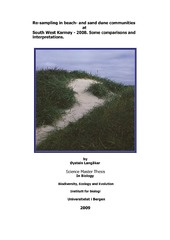| dc.description.abstract | Sandy beaches with accompanying immature dunes as well as mature sand dunes are regarded a rare biotope in Norway. The localities of this survey are situated at the south west coast of Karmøy. As a former resident of the area it has been noticed severe alterations of the landscape within these settings and during the last decades it seems that wear to the vegetation is escalating, probably due to increasing population and leisure activities performed at these beach sites. Also, climatic change might be considered a cause of changes to biota. Some quite rare species have been recorded at these beach localities and it is regarded as the northernmost location for Atriplex lacinata on a world scale. Several other species in this vicinity are also at their fringes of distribution northward. The aim of this study is to provide some more documentation regarding biotic as well as abiotic circumstances and to try to explain changes in vegetation patterns due to results gathered from these observations. It became both challenging and promising that Anders Lundberg had conducted extensive floristic surveys in these semi-natural settings earlier. For his cand. scient degree he surveyed plant communities at several of the beach- and dune localities of South West Karmøy in 1981. As he conducted some transect based studies, it presented an opportunity to conduct re-samplings and thereby to study potential changes in biota over time. It was managed to re-locate the transect routes and the picked sites were at Åkrasanden, Stavasanden and Sandvesanden - mentioned from north to south. These different beach localities provide some quite interesting features as they are exposed differently to human activities. They have also been highly differently subjected to developments during the last part of the twentieth century. In addition to floristic surveys within transects there were also gathered samples from several stabile plant communities characteristic for these vicinities. Two soil properties, pH and Loss on Ignition (LOI) were analysed from each site. Ordinations were chosen for analysing the data gathered from floristic observations within transects. Simpler statistical methods were applied to the soil sample results to be able to depict differences or equalities in mean values between partial or whole transects at the survey sites. From all transects results show an increase in species richness. Simultaneously, it is obvious that wear to the areas have aggravated, especially at Åkrasanden. This can be observed both by comparing older photos with new ones and is also immediately obvious for the local resident. It is a well known phenomenon within biology that a certain degree of disturbance is associated with increase in species diversity. However, some of the wear patterns observed during this survey are quite extensive. Paradoxically, these sites are not included in the study. Whether climatic changes have so far contributed to alterations in biota is not properly treated in this study. There are, however, some observations that might be indicating a trend toward warmer conditions. More topical are probably the biotic observations for the evaluation of the future development of especially the dune meadows, as agriculture has ceased to impose influences and new kinds of human activities have entered the arena. | en_US |
